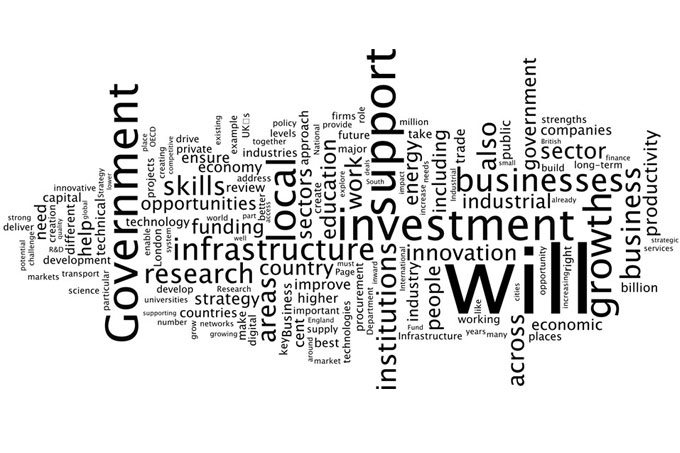Dr Daniel Donoghue examines the recent Green Paper, Building our Industrial Strategy, and its likely impact on Kent.
In January 2017 the Government released a Green Paper entitled Building our Industrial Strategy. To paraphrase the Prime Minister, “this is a modern industrial strategy that will help deliver a stronger and fairer society where wealth and opportunity are spread across every community”.
The document sets out to build on Britain’s strategic strengths and tackle underlying weaknesses by raising productivity and competitiveness. The word cloud above identifies the frequency of usage of particular words throughout the 132 page document.
Government, Support, Business, Investment, Growth, Local, Infrastructure, Skills, Research, and Institutions represent the top 10 themes and one could say these are what you would expect to find in any such strategy. Somewhat surprising is the limited usage of terms such as Knowledge, R&D, Strategic, Policy, Universities, Impact, Global, Education, Digital, Networks, Clusters and Services in the document.
However, what I find very surprising is the near absence of the words such as Regional, Place, Space, Spatial, Disparities, Inequalities, Polarisation, Balance in the word cloud. Since 1979 there has been a steady decline of regional policy and an increase in regional inequalities in the UK and elsewhere.
Neo-liberal thinking has become the conventional wisdom to the extent that the OECD suggests traditional regional policy of redistribution and subsidies for lagging regions should be replaced with measures that increase the competitiveness of all regions. Sound nice, but HOW? While the Strategy does include a section entitled Driving Growth across the Whole Country, and suggests ‘place’ is important, it seems to me these are an afterthought.
The word cloud confirms the Government will follow the new economic orthodoxy espoused by the OECD and groups such as the Competition and Markets Authority (CMA) who are concerned with place-based policies that distort competition and efficiency. I would rather spatially explicit policies that are concerned with limiting inequality and polarisation through (re)balancing investment around the country.
What does the Green Paper mean for us here in peripheral East Kent, one of the only lagging regions in South East England? We should welcome that Infrastructure, Skills, Research and Institutions are amongst the dominant themes identified in the document – it augurs well for Higher Education in Canterbury. Local areas may be able to access a national £12 billion Local Growth Fund though competition is bound to be stiff. Increased investments in infrastructure could see a new Thames Crossing or redevelopment of Kent International Airport at Manston if the political will is there. It is interesting to note one of the few place-based developments identified in the Green Paper is the formation of a Thames Estuary Growth Commission which clearly will have implications for Kent.
My main concern for the immediate future of East Kent is that Brexit will focus the mind of government on national issues and that regional problems, even pressing and persistent ones, will be ignored.
Dr Daniel Donoghue is an urban and economic geographer, in the School of Human and Life Sciences.
Download a PDF of the strategy.
The Green Paper is still open for consultation. Anyone wishing to comment on the Green Paper can do so here by 17 April 2017.
 Expert comment
Expert comment Jeanette Earl
Jeanette Earl 1160
1160


